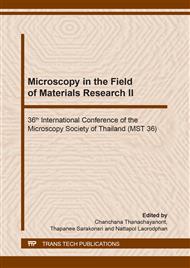p.85
p.93
p.101
p.107
p.115
p.123
p.135
p.141
p.149
Effect of Metal Precursor Solution on Morphology of Porous LaCoO3
Abstract:
Porous materials are attractive in various applications such as energy storage and production, industrial processing, environmental treatment, and catalysis. Porous LaCoO3 was prepared using three different metal precursor solutions: i) 40%v/v methanol-ethylene glycol (40%Me/EG), ii) Lysine (Lys), and iii) Lysine/citric acid (Lys/Cit) with poly(methyl methacrylate) colloidal crystal as porous templates (PMMA-CCT). PMMA-CCT filled with metal precursor solution were carbonized under N2 followed by oxidized under 50% O2 in N2 atmosphere. X-ray diffraction patterns of the obtained porous LaCoO3 are rhombohedral LaCoO3 phase without impurity. The scanning electron microscopy (SEM) was carried out to examine the morphology of porous LaCoO3. The SEM image of the LCO-Lys/Cit exhibits better connected particles and a well-defined pore structure compared to those prepared by Lys or 40%Me/EG metal precursor solutions. The evolution of pore formation of LCO-Lys/Cit was investigated by SEM, Fourier transform infrared spectroscopy (FT-IR), and thermal gravitational analysis (TGA). The materials show high catalytic properties for the electrochemical water oxidation reaction. The high capacitances of all porous LaCoO3 are attributed to the controlled three-dimensional porous morphology of the catalysts. This synthesis approach can achieve porous materials with promising properties for catalysis applications.
Info:
Periodical:
Pages:
135-140
Citation:
Online since:
April 2020
Authors:
Keywords:
Price:
Сopyright:
© 2020 Trans Tech Publications Ltd. All Rights Reserved
Share:
Citation:


